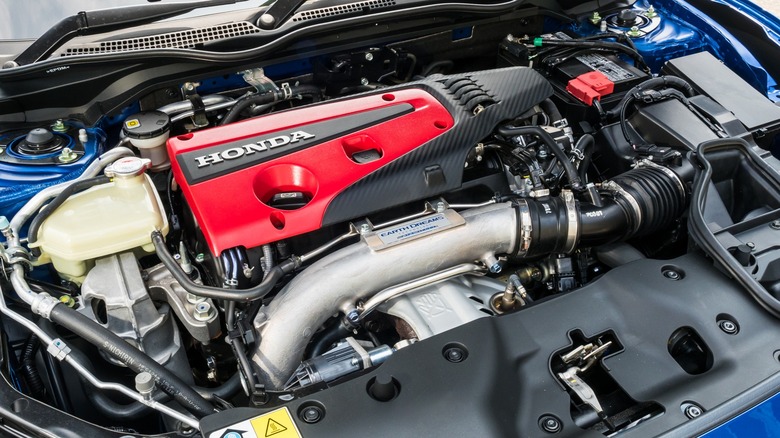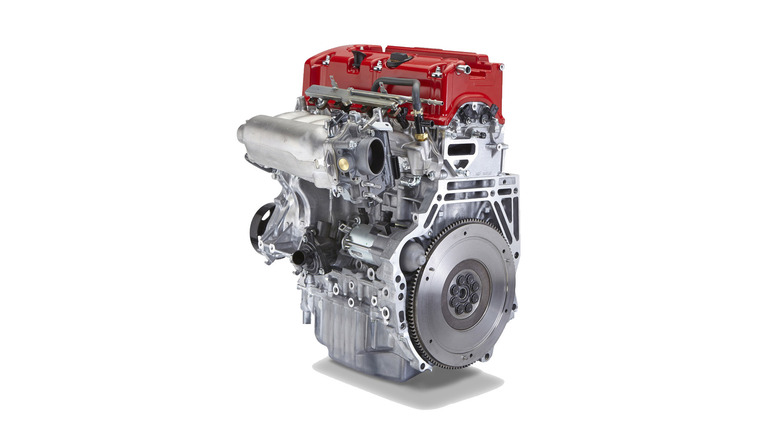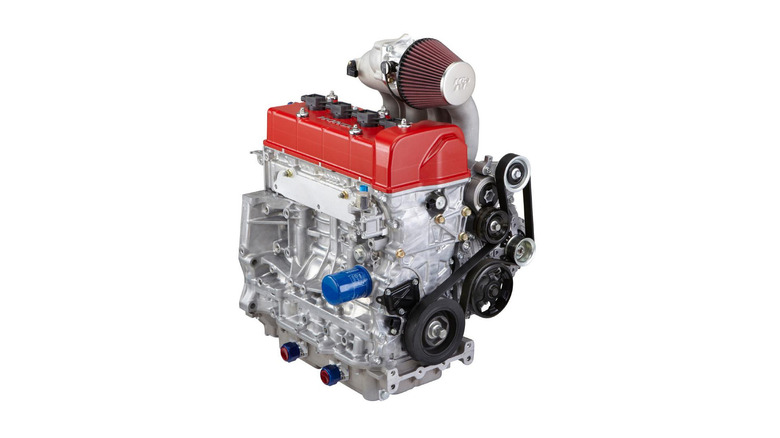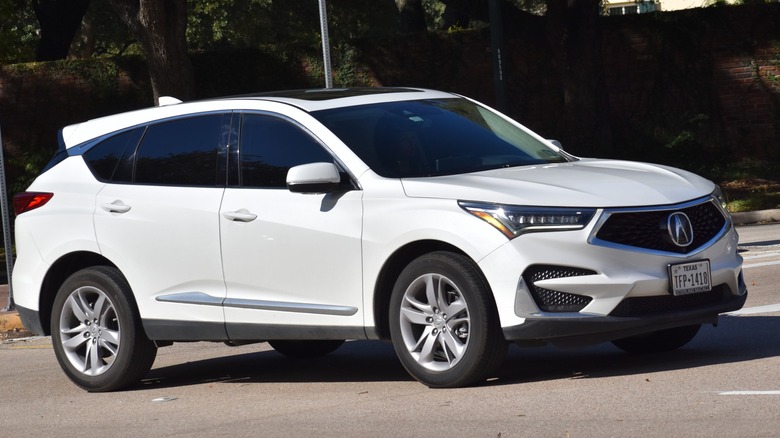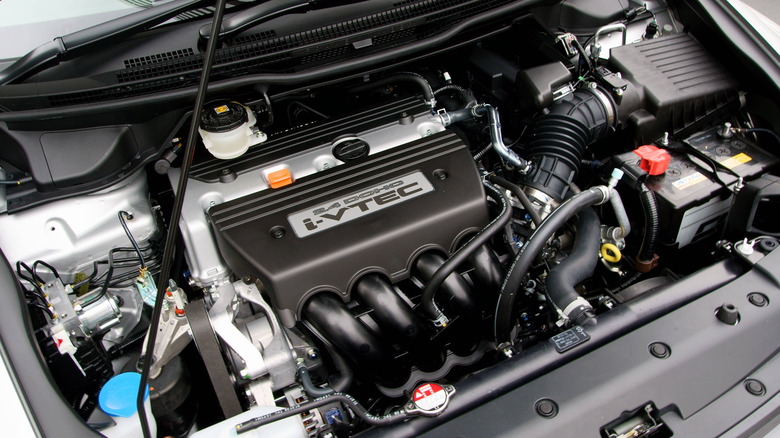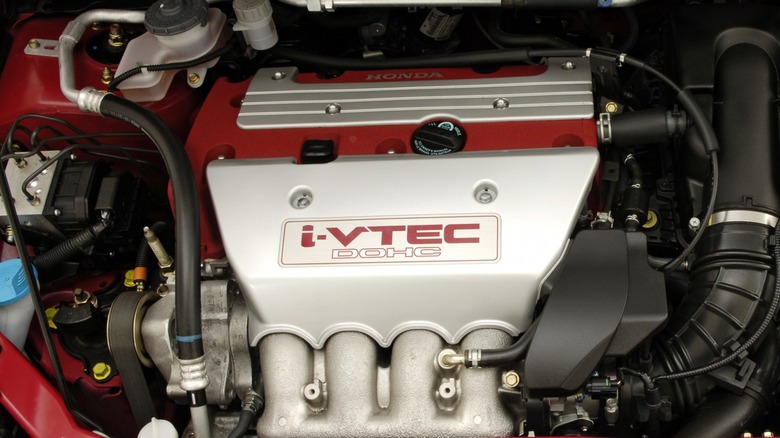Everything To Know About The Honda K-Series Engine
There's almost zero chance that Honda engineers knew they were making what would become one of the most beloved engines in car culture when they released the K-Series engine. In the past, we've touched on what made the K24 engine so special. However, limiting ourselves to just one engine in the K-Series family is truly doing the engine lineup an injustice. If you think of virtually any important Honda model for the past 20 years, there's a decent chance there's a K-series engine under the hood. The K-series engine still feels like a relatively new development, but it is, in fact, over 20 years old now.
Honda first brought the K-series engine to the world under the hood of the 2001 Honda Civic Type R and 2001 Honda Integra Type R. Of course, the U.S. did not get those vehicles. Instead, the K-Series hit the U.S. market a year later with the 2002 Acura RSX, the EP3 Civic Si (slightly watered-down versions of the Type R models), and the ever-loved crossover, the CR-V. Since then, the K-series family has grown, modernized, and become cult-loved in the tuner community, working its way under the hood of almost any vehicle you could imagine, whether it's front, rear, or all-wheel-drive.
K-Series Techincal Data
The K-Series is a standard dual-overhead-camshaft inline four-cylinder engine layout. Both the engine block and cylinder head are made from aluminum. Initially, the K-Series used standard multi-port fuel injection, meaning the fuel injectors spray fuel into the intake manifold, and the valves control its entry into the combustion chamber. However, later versions of the K-series switched to direct injection, with the injectors spraying fuel directly into the combustion chamber. In addition, early K-series engines were solely naturally aspirated. However, as the K-series lineage grew, forced induction via a turbocharger came from the factory, depending on the model.
The K-series combines Honda's already noteworthy capability to build efficient, robust, and dependable engines with a timing chain that rarely needs servicing and strong rotating assembly components. Because of this, it's not uncommon to see K-series engines lasting well over the 200,000-mile mark. Honda also used these engines for racing, so they're no strangers to abuse. This is why they became such popular platforms for modification. Without any internal upgrades, K-series engines are known to be capable of over 400 horsepower with added forced induction and proper tuning.
Of course, we can't bring up an iconic Honda engine without mentioning VTEC. K-series engines use Honda's i-VTEC system, which implements both variable valve timing and varying camshaft profiles. This allows maximum efficiency across virtually every feasible engine RPM.
K20
The K20, as you might assume based on the name, has a displacement of two liters. Though it was born with the Type R models, as discussed above, the K20 found its way into a myriad of different Honda models over the years. These include the Acura RSX and RSX Type S, Honda Accord, CR-V, and even the legendary modern Honda Civic Type R. In addition, Honda also used K20 engines in the United States Formula 4 racing championship.
Depending on the model, naturally aspirated variants of the K20 saw up to 221 horsepower and up to 159 lb-ft of torque. One of its notable claims to fame is its impressive rev range, with some models reaching a redline of 8,600 RPM.
Later variants of the K20 that implemented turbocharging and direct injection saw a substantial increase in power output. At 306 horsepower and 295 lb-ft of torque, the turbo K20 is truly a monstrous evolution of this platform.
In terms of swaps and high-horsepower starting points in the K20, the K20Z3, found in 2006 through 2011 Honda Civic Si models, is one of the most desirable for its high-flowing cylinder head. Similarly, the K20Z1 from later model year RSX Type S examples are sought for the same reason.
K23
Often overlooked, the K23 was a 2.3-liter variant of the K-series that did not last all that long. Spanning model years 2007 to 2012, the K23 was found solely in the Acura RDX. It shares the "tall block" with the K24 (9.1-inch block height vs the K20's 8.3 inches). All K23s were turbocharged and made 240 horsepower with an accompanying 260 lb-ft of torque.
The K23 wasn't long for this world because it, quite frankly, was fairly dull. The power output sounds decent, but the RDX platform itself was a bit uninspired with its 0-60 time of around seven seconds. It wasn't all that nimble and managed an almost impressively low 19 mpg city and 24 mpg highway EPA rating. Even though it's in a compact SUV, that's not a phenomenal fuel economy rating for a turbo four-cylinder, even by the standards of the time. Ultimately, the first-generation RDX flopped, and its replacement came with a V6 engine. Just like that, the lowly K23 came to an end.
K24
The K24 uses the same 9.1-inch block height as the K23. However, it did not fall to the same fate. Instead, the K24 shares the limelight with the K20 and is regarded as one of the greatest engines ever by Honda. The K24 is also found in a slew of Honda models, including the Accord, CR-V, Odyssey, Crosstour, Element, and ninth-generation Civic Si. In addition, the K24 powers Acura ILX, TSX, and TLX models.
On the high end, the K24 family made up to 206 horsepower and 182 lb-ft of torque. Much like the K20, though, the robust build quality and proven reliability of the K24 make it a popular swap and tuner candidate. With aftermarket parts, there are a handful of K24 engines making north of 1,000 horsepower.
Unlike the K20, the K24 did not get a turbocharged variant as the family continued to grow. As of the 2024 model year, the only remaining Honda vehicle using the K24 is the Honda Odyssey. Specifically, only the Japanese-delivered models.
[Featured Image by Hatsukari715 via Wikimedia Commons | Cropped and Scaled | Public Domain]
Common K-Series Engine Problems
Though the K-series is known for its robust build quality and dependability, nothing is without its faults. The K-series has a couple of things to keep an eye on if you own one or plan on it.
If your K-series engine is making a ticking sound from the top end, there's a good chance you'll need to adjust the valve lash. If it's not making any noise, it's important to ask the seller if it has had a valve adjustment. Though it's a relatively quick and inexpensive job, leaving it unmanaged can have detrimental effects on engine health.
Honda recommends replacing the timing chain at 120,000 miles. If the engine has more mileage than that, it's important to ask if it's been replaced. Timing chain failure will lead to pistons contacting valves and require an engine rebuild or complete engine replacement if the damage is substantial enough.
Early K20 engines occasionally have problems with cylinder four overheating, so a compression test is always a good idea. Overheating can cause the head or block to warp and cause a failed head gasket.
Finally, direct injection K-series models can experience substantial carbon buildup on valves since there is no fuel spraying atop the intake valves, as you'd find in a standard multi-port injection setup. Getting high-mileage direct-injected K-series engines media blasted can alleviate this issue.
